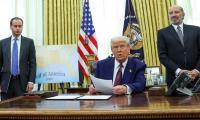enrichment altogether, to ensuring that it’s slowed down. Although Iran hasn’t given up its ‘sovereign’ nuclear options, it has a conceded a lot, mainly because the sanctions hurt it badly.
Yet, it’s not certain that the deal will be finalised by June 30. Almost half the US Senate, which must ratify it, opposes it. So does Israel under its re-elected fanatically hard-line leader Binyamin Netanayahu, who recently addressed the US congress in an unprecedentedly confrontationist move vis-a-vis President Obama.
Mercifully, Iran’s hardliners are unlikely to sabotage the agreement with ‘the Great Satan’. President Hassan Rouhani, Iran’s former chief nuclear negotiator, who wants improved relations with the US and EU, seems as strongly supportive of the agreement as Foreign Minister Mohammad Javad Zarif who signed it.
Opinion polls say 96 percent of the Tehran public backs the agreement. By all indications, supreme leader Ayatollah Ali Khamenei, who had issued a fatwa that declaring nuclear weapons un-Islamic, seems inclined to go with moderate opinion. Saudi Arabia has welcomed the deal despite its misgivings about Iran’s nuclear programme – probably in deference to domestic sentiment.
However, talks to reach final agreement could stumble on one or more of any number of issues left unsettled. Moreover, the two sides have put different spins on what was agreed. It’s not clear whether the Arak reactor core will be ‘destroyed’ and ‘removed’ (US), or ‘will remain’ but not be used (Iran), and whether the timeframe for limiting enrichment to 3.67 percent is 15 years (US), or 10 years (Iran).
The US says sanctions relief would kick in only after the conditions for inspections are verifiably met; Iran says this would happen immediately after “a comprehensive agreement”.
These are delicate issues: negotiating them will demand diplomacy and a degree of trust which goes beyond the cold calculation that usually underlies arms-control deals between adversaries.
The Lausanne negotiations must be seen in a larger perspective. First, the US decided about two years ago that it could drive a deal with Iran while retaining its own hegemonic advantage – unlike in the past. In 2003, Britain, France and Germany (EU-3) came close to reaching a deal. But the US wasn’t part of the negotiations and scuttled the agreement.
In 2010, Turkey and Brazil too worked out a reasonable agreement, but the US would have nothing to do with it. It wanted a monopoly on the process. The US abused its influence in the IAEA to get it to publish in 2011 a highly biased report which concluded that “Iran has carried out activities relevant to the development of a nuclear device”.
This was based on dubious, uncorroborated sources. Alarmist stories were planted about Iran’s ‘breakout’ time (for producing 20 kg of 90-percent-enriched uranium) being a mere three months.
By early 2013, the Obama administration’s assessment had changed. It opened a back channel to Iran that led to several secret bilateral meetings. The process got strengthened with Rouhani’s election as president in June, and led to a breakthrough ‘interim’ agreement in November. This paved the way for further talks, leading to Lausanne.
Second, the US seems to have recently concluded that Iran can be a source of cooperation, if not a de facto ally, against the Taliban in Afghanistan and the Islamic State in West Asia. Iran has long played a role supportive of the US in Iraq, where Tehran wields great influence because of Iraq’s Shia-majority population and could have created trouble.
Iran is proactively attacking the IS in Iraq and Syria. In Tikrit, Iran has launched a massive offensive against Sunni rebels under the cover of the US-led war on terrorism. The US will sooner or later have to recognise Iran as a major player in the region.
Third, Iran is itself keen to be seen as a ‘normal’, stable, responsible state, not the ‘rogue’ state it has been made out to be. It’s a rising power. In spite of its hard-line clerical-Islamist regime, it hasn’t behaved like a belligerent power – unlike Saddam Hussein’s Iraq or today’s Saudi Arabia. Iran is what international-relations theorists term a ‘rational actor’ and status quo power, which wants regional stability.
Iran’s has used its nuclear programme, among other things, as a bargaining chip in its regional self-assertion efforts. It stretches credulity to claim that an oil- and gas-rich country like Iran needs nuclear power for its energy security, or that nuclear power is a reliable, safe energy source after Fukushima.
Iran has used the ‘right’ to develop nuclear energy, available to all states under the Non-Proliferation Treaty, which was drafted to rationalise nuclear weapons through the fig leaf of ‘Atoms for Peace’. The world is paying a colossal price for this monumental deception.
Post-Lausanne US-Iran reconciliation would make for a less violent, less unstable West Asia. This is in the interest of South Asia’s people – witness the negative example of Yemen. They have much to gain from a prosperous Iran, and in the short run, from low oil prices.
India committed a blunder by voting against Iran in the IAEA – not once but twice, under US ‘coercion’, thus undermining the Iran-Pakistan-India gas pipeline project. The present moment gives India a chance to make amends and return to that project.
Even more important, it offers India and Pakistan a joint opportunity to secure Iran’s cooperation in helping make Afghanistan a stable and prosperous democracy.
The writer, a former newspaper editor,is a researcher and rights activistbased in Delhi.
Email: prafulbidwai1@yahoo.co.in
This demand has fueled rapid growth deposit base of Islamic Banks and Islamic Windows operated by conventional banks
But Punjab Agriculture Food and Drug Authority building near Thokar Niazbeg on Multan Road stands out
Macron has been particularly vocal in their criticism, asserting that withholding arms from Kyiv plays directly into...
As PPP governs province, Bilawal Bhutto Zardari holds strategic position to address both violence and its underlying...
Critics argue that strategy is vague, but closer look indicates strategic alignment with global trends and national...
To defeat it, we must distrust bot-driven narratives, to defeat it, we must verify sources before believing or sharing







